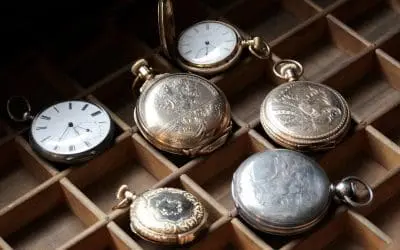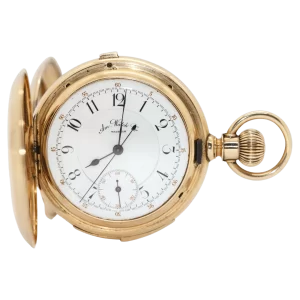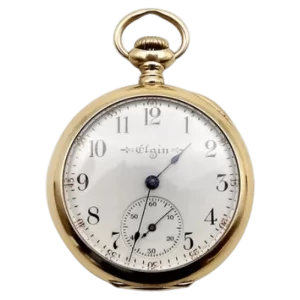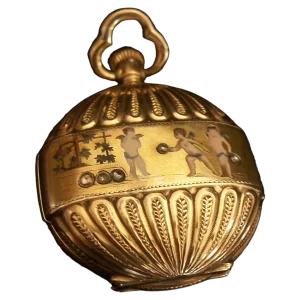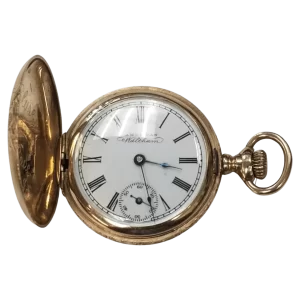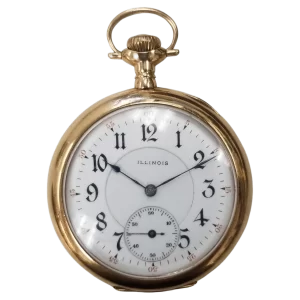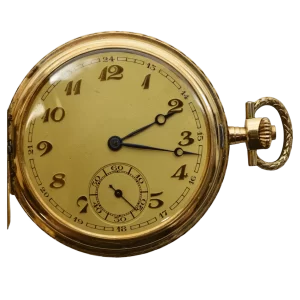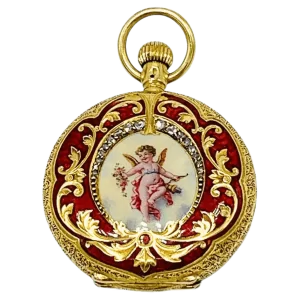Antique pocket watches are not just timepieces, they are also cherished pieces of history. However, these delicate watches are prone to wear and tear over time, and require careful maintenance and repair to keep them functioning properly. In this blog post, we will explore common antique pocket watch problems and solutions to help you keep your watch in top condition.

Common Mechanical Issues Found in Antique Pocket Watches
Antique pocket watches are delicate and intricate mechanisms, so it’s not uncommon for them to experience mechanical issues over time. Here are some of the most common problems you may encounter and how to address them:
Worn-out mainspring
A worn-out mainspring is a common issue that can cause the watch to stop running. The mainspring is the coiled spring that powers the watch’s movement, and it can become weak or even break over time. If your watch is no longer functioning, this could be the issue. The solution is to have the mainspring replaced by a professional watchmaker.
Over-winding the watch
Over-winding the watch can cause damage, so be sure to wind it slowly and carefully. You should stop winding as soon as you feel resistance and never force the mechanism if it refuses to wind. Also, make sure to wind the watch at the same time every day to ensure accurate timekeeping.
Loose or broken hands
Another common issue is loose or broken hands. The hands are the small metal indicators that point to the time on the watch face. If they become loose or break off, you will need to replace them. This can be done by a professional watchmaker who will carefully install new hands that are perfectly aligned with the hour markers.
Movement issues
Antique pocket watches have complex movements that can suffer from issues such as rust, dust, or debris. When this happens, the movement may become sluggish, inaccurate, or stop altogether. A professional can disassemble the watch and clean or oil the movement to restore its functionality.
Worn-out balance wheel
The balance wheel is a key component of the watch movement that controls the timing of the watch. If it becomes worn or damaged, the watch will not keep accurate time. A professional can replace the balance wheel or make the necessary adjustments to restore its function.
Conclusion
Mechanical issues are common in antique pocket watches, but they can be addressed by a professional watchmaker. If you encounter any problems with your watch, don’t attempt to repair them yourself, as this can cause further damage. Instead, take your watch to a qualified professional for proper diagnosis and repair.
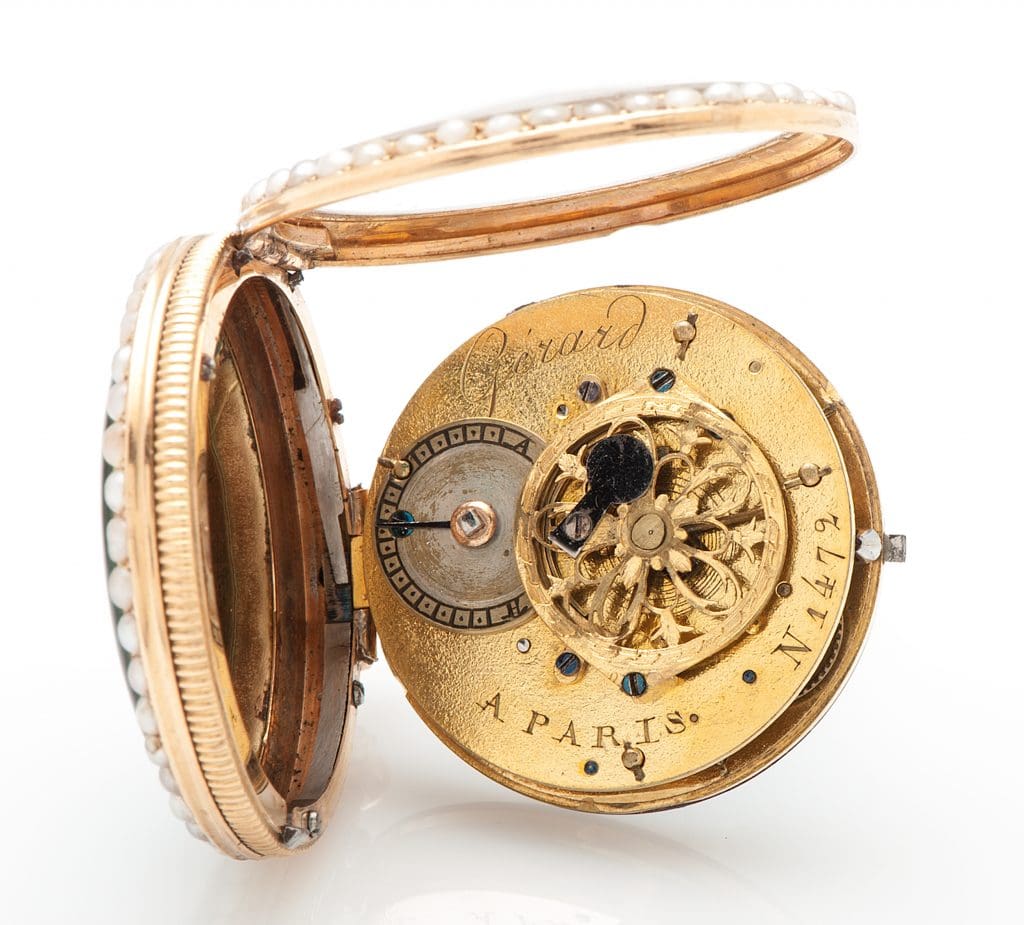
Identifying and Addressing Rust in Your Antique Pocket Watch
One of the most common issues that antique pocket watches face is rust. Rust can cause the watch to stop running or even damage its delicate components. Here are some steps you can take to identify and address rust in your antique pocket watch:
Clear away any dirt or debris on the watch before addressing rust
Before you try to remove rust from your antique pocket watch, it is essential to clear any dirt or debris from the watch. Use a soft and non-abrasive cloth to wipe the watch carefully.
Use a rust remover that is safe for antique watches and a gentle cleaning solution to restore the watch’s appearance
To remove rust, you can use a gentle cleaning solution that is safe for antique watches. Rub the solution on the rust build-up, and use a cotton swab or soft cloth to wipe it away.
For stubborn rust, you can use a rust remover that is safe for antique watches. However, be careful when using rust removers as they can cause damage to the watch if used incorrectly.
Once you have removed the rust stains, use a dry and soft cloth to dry the watch. It is essential to keep the watch completely dry to avoid any further rust from setting in.
If the rust has caused damage to your watch, it’s essential to take your antique pocket watch to a professional. They can assess the damage and recommend the best course of action to restore your watch’s appearance and functionality.
Repairing Cracks or Chips in Your Antique Pocket Watch’s Glass Face
Antique pocket watches often have delicate glass faces that can crack or chip with use or over time. If this happens to your pocket watch, there are a few steps you can take to repair it.
Small chips or cracks
For small chips or cracks in the glass face, you can use a clear adhesive to fill in the damaged area. Apply a small amount of adhesive to the damaged area, being careful not to apply too much. Allow the adhesive to dry fully before handling the watch again.
Beyond repair
If the damage is beyond repair or if the crack is significant, a professional may need to replace the entire glass face. This is a delicate procedure that should only be performed by an experienced watchmaker to ensure the correct replacement glass is fitted.
It’s important to note that attempting to repair the glass face yourself or using an inexperienced watchmaker can cause further damage to the watch, so it’s always best to seek professional help if you are unsure.
How to Properly Clean and Maintain Your Antique Pocket Watch
Antique pocket watches require delicate handling and regular maintenance to ensure their longevity. Here are some tips for cleaning and maintaining your antique pocket watch:
Clean the Surface of Your Watch
First and foremost, use a soft, non-abrasive cloth to wipe off the surface of your watch. This should be done after each use to prevent dirt and oil buildup. Avoid using water or any harsh chemicals, such as ammonia-based cleaners or alcohol, as they can damage the surface of your watch.
Clean the Inner Components of Your Watch
It’s important to keep the inner components of your watch clean and free of debris. However, only a professional with the proper tools and experience should attempt to clean the inside of an antique pocket watch. If you suspect that your watch needs to be cleaned on the inside, bring it to an experienced watchmaker.
Pack Your Watch Properly
When not using your antique pocket watch, make sure to pack it properly. Avoid exposing the watch to extreme temperatures or moisture, as this can damage its delicate components. Store the watch in a dry, cool place and handle it carefully to avoid dropping or scratching it.
Determine Your Service Needs
Antique pocket watches require periodic servicing to keep them in top condition. This involves a comprehensive cleaning and inspection of the watch’s internal components. The frequency of servicing depends on the age, condition, and usage of your watch. Generally, it’s recommended to have your watch serviced every 3-5 years.
By following these tips, you can ensure that your antique pocket watch stays in excellent condition for years to come.

Signs Your Antique Pocket Watch Needs a Professional Cleaning
While you can do some maintenance and cleaning on your own, there are times when you may need to seek the assistance of a professional to properly care for your antique pocket watch. Here are some signs that your watch may need professional attention:
- Your watch is losing time or not working at all
- There is visible dirt or grime buildup on the watch, or it has been exposed to moisture
- You notice any unusual noises or resistance when winding or setting the watch
- The watch is running too fast or too slow
- There are visible scratches or other damage to the watch face or other components
If you notice any of these signs, it’s important to bring your watch to a qualified professional for cleaning, maintenance, and repair. A trained watchmaker will have the tools and expertise necessary to properly care for your antique timepiece and ensure that it stays in good condition for years to come.
Fixing or Replacing Antique Pocket Watch Hands
If your antique pocket watch has a damaged or broken hand, it can be a relatively simple fix. Here’s how to repair or replace the hands:
- Using a pair of tweezers, gently remove the damaged or broken hand from the watch.
- Choose a replacement hand that matches the style and size of the hand you removed.
- Align the new hand with the time markers on the dial of the watch.
- Gently press the hand into place, taking care to ensure that it is properly seated and level with the other hands.
- Wind the watch slowly and check the time to ensure the hands are functioning properly.
If you’re unsure about repairing or replacing your antique pocket watch hands, it’s always best to seek the advice of a professional watchmaker. They will have the experience and tools necessary to complete the repair or replacement with precision and care.
Replacing an Antique Pocket Watch’s Broken or Missing Stem
If your antique pocket watch’s stem is broken or missing, don’t worry – it’s a common problem that can be fixed with the right tools and a steady hand. Here’s how to replace it:
- Remove the case back of the watch to expose the watch movement. Be careful not to damage any other components while doing so.
- Locate the stem on the watch movement. It should be near the winding mechanism.
- Using a pair of tweezers, carefully remove the broken or missing stem from the watch movement.
- Insert the replacement stem into the same spot where the old one was located. Make sure it is properly aligned and secure.
- Gently reattach the case back and test the watch’s functionality.
It’s important to be extremely careful when working with the delicate components of an antique pocket watch. If you’re unsure about replacing the stem yourself, consider consulting a professional to ensure that the repair is done correctly and safely.
The Importance of Regular Antique Pocket Watch Servicing
Antique pocket watches were built to last, but like any piece of machinery, they require regular maintenance to keep them running smoothly. Over time, the delicate components of an antique pocket watch can become worn, and dirt and debris can accumulate in the gears and workings. If these issues are not addressed, they can cause more serious damage to the watch and shorten its lifespan.
Regular servicing by a professional watchmaker can catch and address any issues before they become more severe. During a service, the watchmaker will fully disassemble the watch, clean each component, and lubricate the necessary parts to ensure smooth operation. They will also inspect for any signs of wear or damage and make any necessary repairs to prevent further issues.
By scheduling regular servicing for your antique pocket watch, you can prolong its lifespan and ensure that it continues to run smoothly for years to come. It is recommended to have your watch serviced every 3-5 years, depending on its usage and age. Neglecting regular servicing can lead to more expensive repairs down the line or even permanent damage.
Remember, an antique pocket watch is not only a valuable piece of history but also a functional timepiece. By taking proper care of your watch, you can preserve its value and keep it running smoothly for future generations to enjoy.
Conclusion
In conclusion, antique pocket watches can be a valuable and cherished piece of history. However, it is important to properly maintain and care for them in order to preserve their value and functionality. By addressing common issues such as worn-out mainsprings or rust, and regularly servicing your watch, you can enjoy its beauty and timekeeping for years to come. Remember to handle your antique pocket watch delicately and avoid exposing it to harsh elements, and it will continue to be a cherished heirloom for generations to come.



